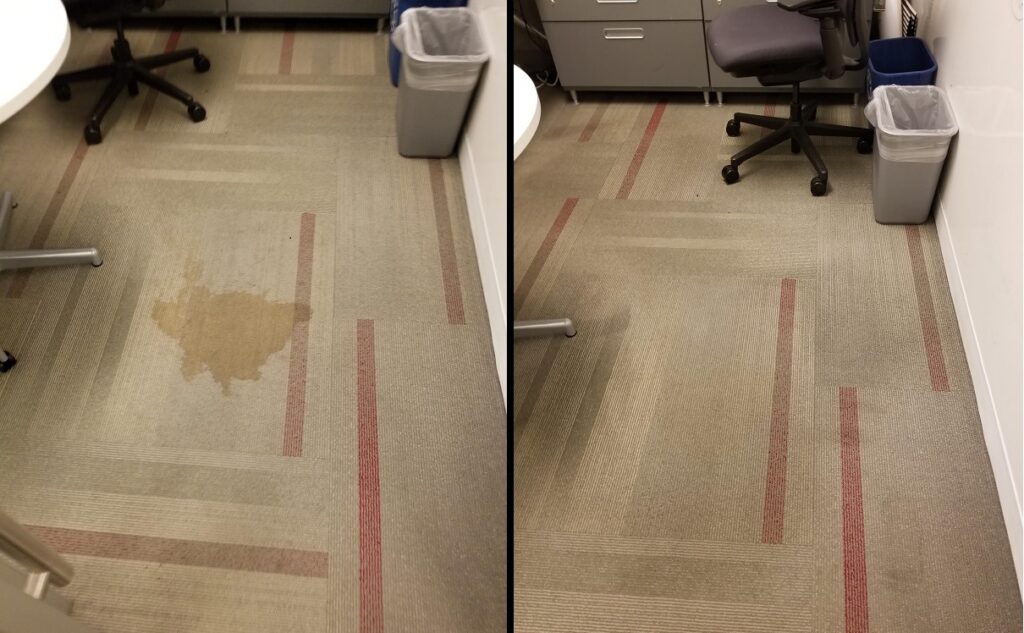There are many types and styles of carpet found throughout commercial workspaces, and there’s one thing they all have in common. It’s the need to be appropriately cleaned for health as well as appearance. More than ever, facility managers are adjusting carpet cleaning and maintenance methods and frequencies. An essential part of cleaning for health protocols is periodic deep cleaning performed by surface care specialists.

Guidelines for Deep Cleaning Carpets for Health
While carpets need daily and weekly cleaning by a facility’s janitorial team, they also require interim deep cleaning. This extends carpets’ useful life, keeps them looking clean, and most importantly, keeps infection risk to occupants low. Outsourcing deep cleaning to surface care experts allows for customized, frequency-based programs that provide the clean and healthy outcome FMs require—and expect.
Plenty of carpet cleaning advice is available from carpet mills and organizations like the CRI (Carpet and Rug Institute). These guidelines include preventative maintenance using walk-off mats, spot and spill clean-up, vacuuming daily or even more often, and prescriptive interim deep cleaning.
However, these organizations’ interim deep cleaning guidelines can range from quarterly to “only when required. Instead, FMs should consider frequency-based programs that assess the cleaning needs in various traffic areas and prioritize where the soil is rather than using traditional frequency guidelines.
Advantages of Preventative Carpet Maintenance
Preventative maintenance is an intelligent approach to carpet care. Periodic carpet maintenance can save costly carpet replacement down the road while improving the facility’s indoor health and the overall perception of the company’s brand.
A reputable surface care provider will start with a free consultation to understand all the variables associated with the facility’s carpet. Then they will identify specific needs based on those details. Next, the provider will develop an outcome-based, customized surface care plan tailored to the building’s requirements.
Primary Ways to Deep Clean Carpets
The service provider’s plan for the facility will include one or more of the three primary ways to deep clean carpets professionally after a thorough vacuuming: low moisture, hot water extraction, and dry cleaning.
Low moisture: This method is ideal for interim cleaning between deeper dry or wet cleaning extractions.
Wet extraction: Wet extraction is a great solution for annual deep cleaning or restorative maintenance. It balances effectiveness and sustainability. Wet extraction relies on safe ingredients for low environmental impact but uses the most water.

Dry extraction: Dry extraction is the best long-term solution for new carpet and the most effective and sustainable solution overall. Dry extraction keeps the facility’s environmental footprint low while reducing workplace VOCs (volatile organic compounds).
How to Reduce Germs and Bacteria
After vacuuming, regular deep cleaning keeps carpets clean and healthy. But according to the U.S. Environmental Protection Agency, only hard surfaces can be disinfected. There are, however, EPA-List N disinfectants available to sanitize carpets and other soft surfaces. These can be applied using hot water extraction. To adequately sanitize the carpet, the provider must follow the chemical manufacturer’s guidelines on the labels for application, dwell times, and dilution rates.
Tips for Choosing Expert Commercial Carpet Care
Cleaning for health is equally as important as cleaning for appearance. Carpet that looks, feels, and smells clean brings peace of mind to building occupants, reassuring them the facility is clean and healthy.
When selecting a surface care provider, consider choosing an IICRC-certified firm whose carpet care systems are CRI certified. These providers use sustainable carpet care methods, products, and processes, protecting indoor air quality while reducing carpet impact on landfills.
Select a firm that will create a customized, outcome-based surface care plan that considers your facilities’ needs. The plan must use best practices while complying with the specifications and recommendations of each carpet manufacturer to guarantee the best results. In addition, the provider should employ professional, trained, and certified craftsmen. Finally, after service, the provider should ensure spaces are clean and healthy through testing, certification, and the exacting standards their technicians bring to the carpet care program.
Michael S. Crippen is the Founder and CEO of SOLID Surface Care. A graduate of The Citadel with a degree in Business Administration, Mike began his career as a commercial flooring sales representative and founded Commercial Flooring Solutions in 1996. He transformed this venture into the client-centric organization that SOLID is today.
